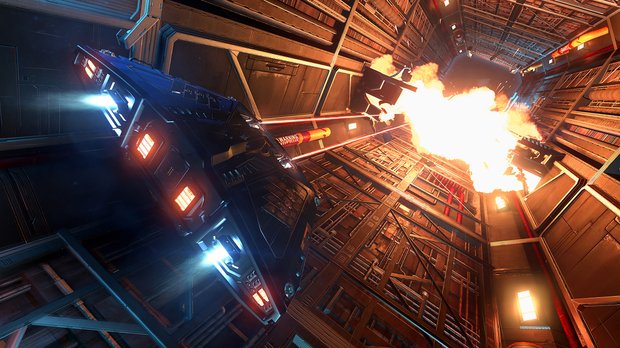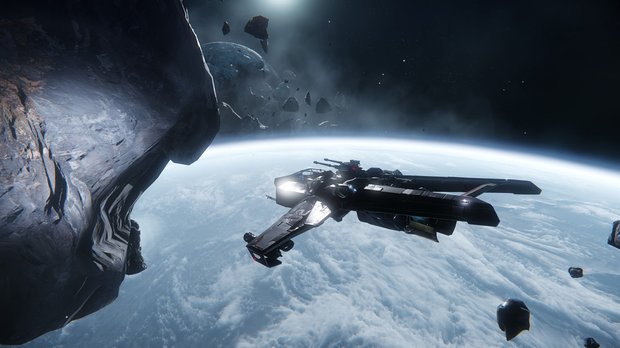Why No Man's Sky will reignite the space sim renaissance
Maybe history really is cyclical.
Video games certainly make that case, especially in the last few years as genres long thought dead are resurrected and reinvented: fighting games; isometric, turn-based RPGs; and perhaps the oddest of all, hardcore space sims.
Led by a reanimated Elite franchise and the crowdfunding juggernaut Star Citizen, space sims have risen from their late-90s grave and are the focus of some of the most lively communities in gaming.
But why? Why in 2016 are people turning back to a genre popularly considered for a long time to be archaic and no longer commercially viable? And what does No Man's Sky, the newest competitor in this space, this bizarre hybrid of production (putting indie studio Hello Games and platform holders like Sony in bed together) and genres (survival-game-cum-space-sim), have to do to capture the old heads that are still charting galaxies and trading organophosphates for engine components?

First, we should chat about what defines a space sim. Back in the TIE Fighter/Wing Commander heyday, space sims were linear affairs. You got a mission brief in a usually poorly modeled (but nonetheless cool looking) briefing room aboard a massive capital ship, and then flew out of the hanger to go shoot down space torpedoes and bombers or take out whatever giant capital ship the cat people/Galactic Empire/alien bugs had brought to bear.
But the modern space sim is so much more than one-off missions with limited objectives, and actually has more in common with old school naval sims, where players built a fortune by exploiting lucrative trade routes and battling (or leading) pirates. Today’s space sims usually include some element of space-trucking, shipping and selling goods from planet to planet, and mercenary work for various factions (building rep with whom usually leads to better rewards and higher paying jobs).
But even a brief dip in the waters of some of these deeply invested communities reveals what is the most powerful and universal appeal of the space sim in 2016: exploration and adventure. Games like Elite: Dangerous succeed (and can be deeply addictive) today because they let players lose themselves, not in vast wildernesses or even the diverse biomes of a single planet, but in the huge, seemingly infinite expanse of space.
Sign up to the GamesRadar+ Newsletter
Weekly digests, tales from the communities you love, and more

That’s the appeal of these sims, the brass ring No Man’s Sky must strive to reach: space opera nostalgia, the romance of the stars, the endless potential for wonder. A great space sim takes the possibility of discovery that lived in every naval sim and blows it out a thousand times.
The powerful sense of uncovering something new and grand and meaningful is heightened in space because you are so perfectly isolated, a sensation No Man’s Sky looks to stimulate with its staggering scope and vast, empty spaces. Not unlike looking out at the open ocean when it extends without end to every horizon, great space sims engender that feeling of isolation, of an explorer at the very edge of the known universe, with nothing but the cold void and the distant twinkling of stars for company.
Hello Games hopes, then, that when you do find yourself staring into the heart of one of those mysteries between the stars, be they mysterious obelisks covered in alien script or the bizarre alien dinosaurs we’ve seen in screenshots, your heart may thump a little in your chest. These bright discoveries will stand out in such vibrant contrast to the darkness of those lonely space lanes and remind us why humanity took to the stars in the first place.
The most dedicated space sim fans cherish this sort of adventure and exploration, as evidenced by the more than a thousand pilots currently flying a giant expedition to the edge of the galaxy in Elite: Dangerous. Dubbed the Distant Worlds Expedition, this ambitious campaign will take somewhere in the vicinity of three months of real time, and will probe the very furthest reaches of the galactic rim.
With that in mind, early indicators look good for No Man’s Sky. The universe it presents is certainly as vast as even the most content hungry player could ever want. The development team at Hello Games has promised that just a one second stop at each of the game’s quintillions of planets would take a player around five billion years. Yes, billion. With a B.

But while the scale is certainly impressive, size alone doesn’t make for a compelling experience. As open world games from Daggerfall to Far Cry have learned, an open world is only compelling if it’s dense with interesting things to do. An open world without sufficient content is more akin to a graveyard than a playground, which is why it’s troubling to hear Sean Murray, the Hello Games co-founder, say things like only one out of every ten planets will yield anything of interest or value to the player.
The other thing is that No Man’s Sky is also a survival game to one extent or another, or at least a crafting game. How will the conceit of searching for resources and building upgrades fit into the game’s central appeal, an infinite universe to get lost in and explore? Striking the right balance in these kind of hybrid games can be difficult, and if not done well, the mechanical systems can begin to feel more restrictive than fun.
There’s no doubt that a game as ambitious as No Man’s Sky is rich with promise, but there are stumbling blocks, and the way the hype train has gathered momentum since Sony got onboard may have elevated expectations to an unreasonable level. While the core audience for a game of its ilk, the space truckers and space Magellans that make a game like No Man’s Sky possible in 2016, are in my experience a friendly, welcoming bunch, they’re also savvy. Will No Man’s Sky deliver the magic they crave and live up to their exacting standards? We won’t know until June, but right now, all signs point to yes.
Alan Bradley was once a Hardware Writer for GamesRadar and PC Gamer, specialising in PC hardware. But, Alan is now a freelance journalist. He has bylines at Rolling Stone, Gamasutra, Variety, and more.



